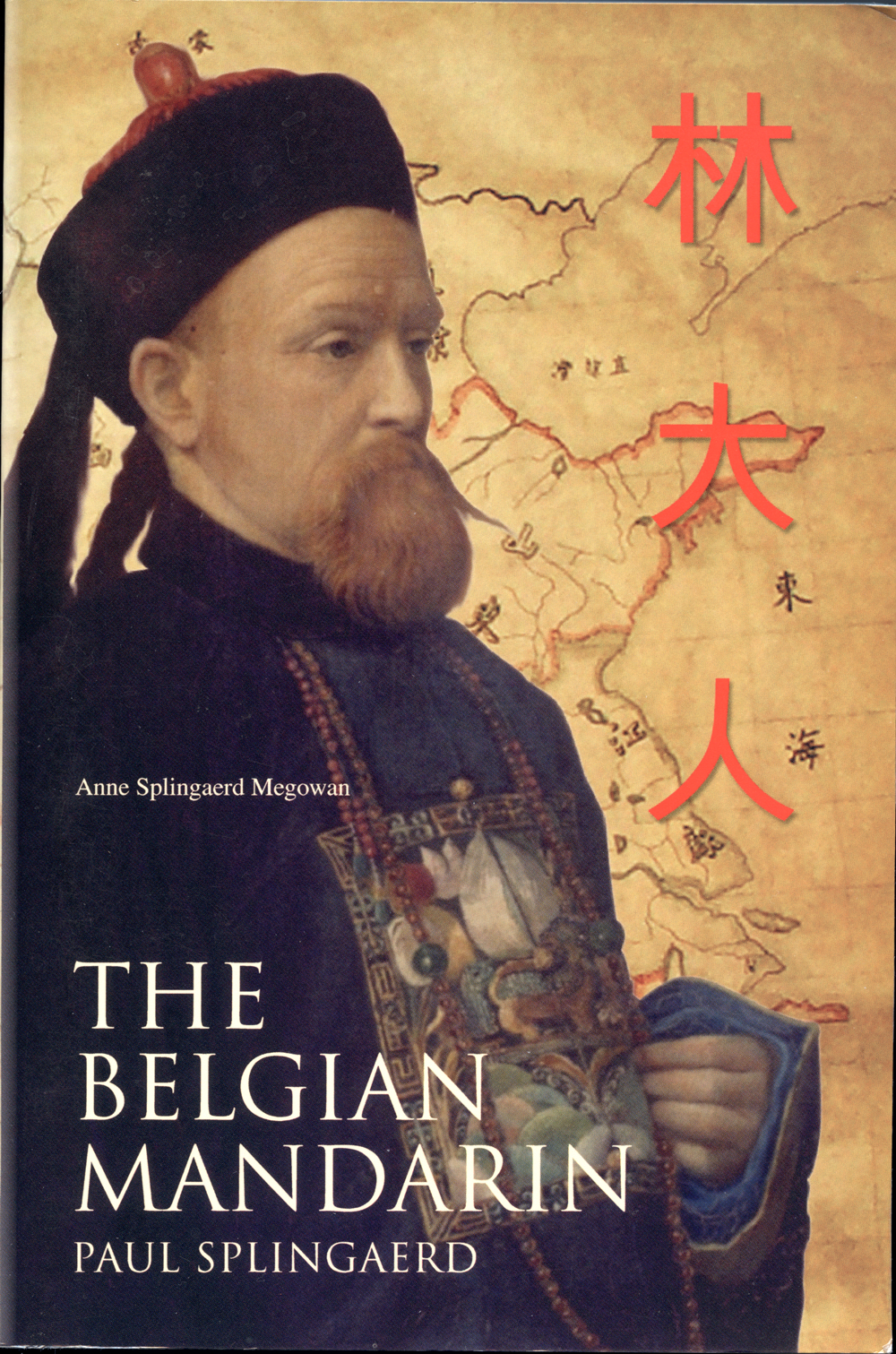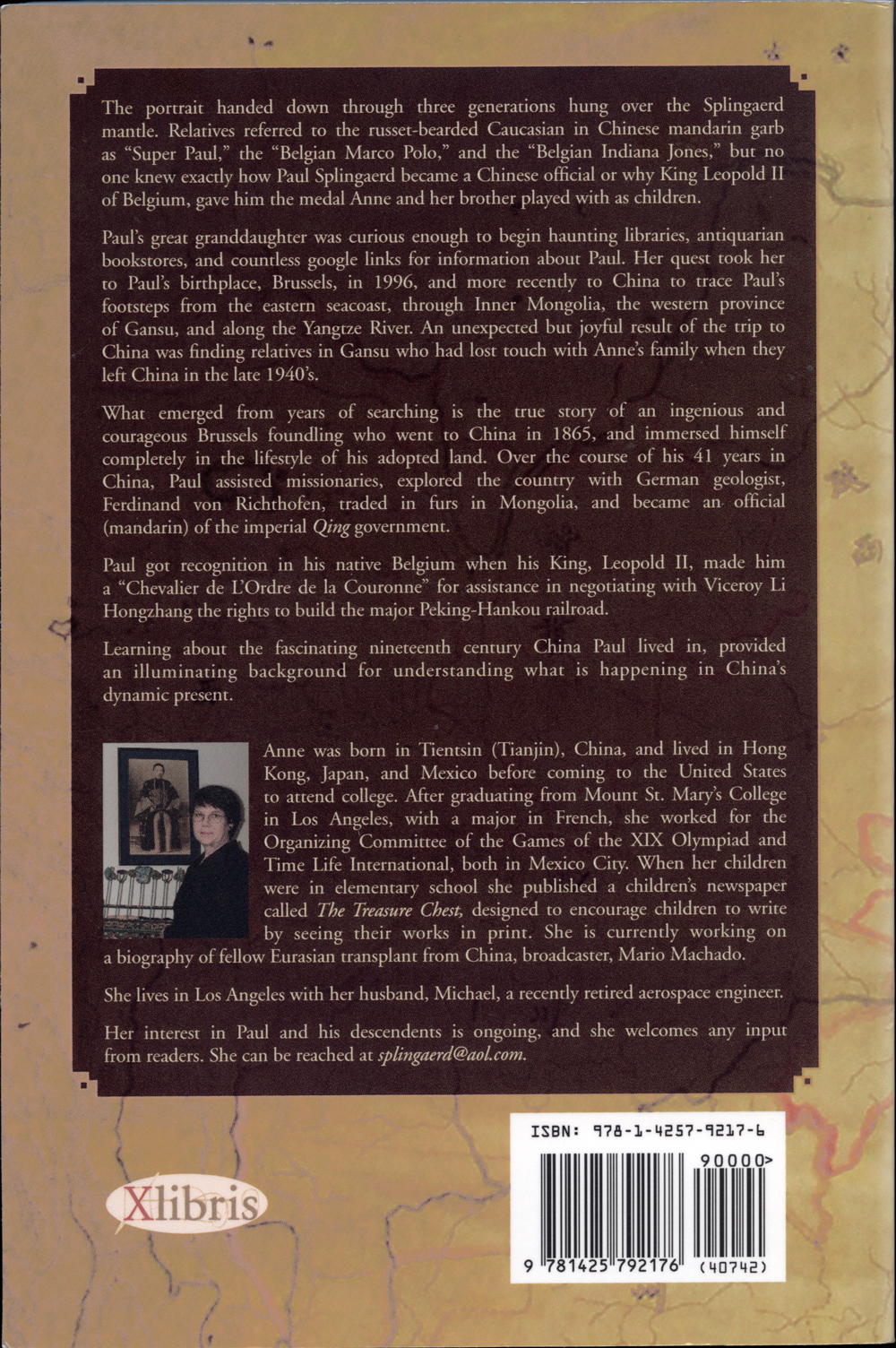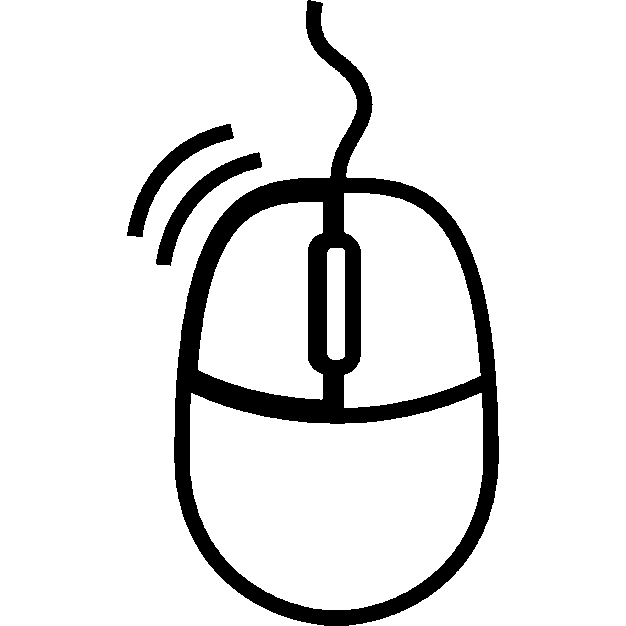
"The Belgian Mandarin"
Paul Splingaerd

Copyright © 2008 by Anne Splingaerd Megowan.
Library of Congress Control Number: 2007908418
ISBN: Hardcover 978-1-4257-9237-4
Softcover 978-1-4257-9217-6
All rights reserved. No part of this book may be reproduced or transmitted in any form or by any means, electronic or mechanical, including photocopying, recording, or by any information storage and retrieval system, without permission in writing from the copyright owner.
This book was printed in the United States of America.
To order additional copies of this book, contact:
Xlibris Corporation
1-888-795-4274
www.Xlibris.com
Orders@Xlibris.com

The portrait handed down through three generations hung over the Splingaerd mantle. Relatives referred to the russet-bearded Caucasian in Chinese mandarin garb as "Super Paul," the "Belgian Marco Polo," and the "Belgian Indiana Jones," but no one knew exactly how Paul Splingaerd became a Chinese official or why King Leopold II of Belgium, gave him the medal Anne and her brother played with as children.
Paul's great granddaughter was curious enough to begin haunting libraries, antiquarian bookstores, and countless google links for information about Paul. Her quest took her to Paul's birthplace, Brussels, in 1996, and more recently to China to trace Paul's footsteps from the eastern seacoast, through Inner Mongolia, the western province of Gansu, and along the Yangtze River. An unexpected but joyful result of the trip to China was finding relatives in Gansu who had lost touch with Anne's family when they left China in the late 1940's.
What emerged from years of searching is the true story of an ingenious and courageous Brussels foundling who went to China in 1865, and immersed himself completely in the lifestyle of his adopted land. Over the course of his 41 years in China, Paul assisted missionaries, explored the country with German geologist, Ferdinand von Richthofen, traded in furs in Mongolia, and became an official (mandarin) of the imperial Qing government.
Paul got recognition in his native Belgium when his King, Leopold II, made him a "Chevalier de I'Ordre de la Couronne" for assistance in negotiating with Viceroy Li Hongzhang the rights to build the major Peking-Hankou railroad.
Learning about the fascinating nineteenth century China. Paul lived in, provided an illuminating background for understanding what is happening in China's dynamic present.

Anne was born in Tientsin (Tianjin), China, and lived in Hong Kong, Japan, and Mexico before coming to the United States to attend college. After graduating from Mount St. Mary's College in Los Angeles, with a major in French, she worked for the Organizing Committee of the Games of the XIX Olympiad and Time Life International, both in Mexico City. When her children
were in elementary school she published a children's newspaper
called The Treasure Chest, designed to encourage children to write
by seeing their works in print. She is currently working on
a biography of fellow Eurasian transplant from China, broadcaster, Mario Machado.
She lives in Los Angeles with her husband, Michael, a recently retired aerospace engineer.
Her interest in Paul and his descendents is ongoing, and she welcomes any input from readers. She can be reached at: — splingaerd@aol.com.


Preface :
The red-bearded Caucasian in Chinese mandarin garb looking down from the frame above my parents' mantle was my dad's grandfather, Paul Splingaerd. He was a Belgian who went to China and married the Chinese lady in the matching frame a few feet away. He was the reason I was born in China, and that was all I knew about him for most of my life.
Through the years, when I asked relatives about Paul, they would tell me he referred to as "Super Paul," the "Belgian Marco Polo," and the "Belgian Indiana Jones," but no one knew exactly how he became a Chinese official or why his king, King Leopold II of Belgium, gave him the medal my brother and I played with as children. A cousin in Belgium produced a heraldic coat of arms for Paul, but it turned out to be a recent creation and not ancestral heraldic arms.
What I found out over thirteen years of research was that Paul had fairly humble beginnings. His lack of an inherited title, wealth, or much formal education did not prevent him from making significant contributions to the Chinese communities he lived in over 41 years in China, enough to become a top-ranking mandarin. This term sounds more impressive than it was, as this title simply refers to an official in the Chinese government. Paul was by no means the first "White Mandarin," or even the first "Belgian Mandarin." The Flemish priest, Ferdinand Verbiest, who with fellow Jesuit, Matteo Ricci, contributed volumes of information about astronomy and western sciences to the Chinese government in the 17''' century, has been the most recognized Belgian mandarin. In Paul's day, an Irishman, Robert Hart, was also made a mandarin for his services as Inspector General of the Imperial Maritime Customs in the Qing government. There were others, as well.
Unlike these other distinguished White Mandarins, Paul was not a "man of letters," and did not leave much of a paper trail beyond a few letters, making it a challenge to find his story. Fortunately, others did write about Paul, and he has turned up (as Splingart, Splingard, Splingaert, Splingerdt, or Spelingeret) in numerous books and documents, some of which are at the Vatican, and archives in Louvain, Germany and China. Ferdinand von Richthofen (see Chapter 5), explorers Sven Hedin and Vladimir Obroutchev (see Chapter 7) wrote about Paul, and he also appears in Chinese books, archives and articles.
When a London newspaper
published a story about Paul, someone submitted the article to Ripley's —
Believe It or Not! — and Mr. Ripley
featured Paul in his November
17, 1929 column. Unfortunately,
although the spelling of his name was
correct, the information about Paul
and the drawing based on a poor
quality photo were not: Paul never
gave up his Belgian citizenship, he
did not have long nails, and what
looks like a piece of paper in his hand
is actually an embroidered mandarin
patch, which like the missing finial
on his hat, denoted his rank. (See
Chapter 7 for more on mandarin
attire and accoutrements.)
In 1984 a Belgian priest named Jozef Spae published a book in Flemish about Paul, entitled Mandarijn Paul Splingaerd. Although written from the limited perspective of the missionaries who brought Paul to China in 1865, Spae's book provided a launching point for my research into Paul.
My cousin Angela Elliott of Vancouver told me about this book. Right after the major Los Angeles Earthquake in January of 1994, she called to find out how we fared, and in the course of our conversation, told me about the Spae book. I immediately ordered two copies. One was for myself, and the other for my brother. Peter. the last male Splingaerd in the family.
Since the Spae book was in Flemish. and my command of Flemish was virtually non-existent, I called the Belgian Embassy to find out about getting the book translated into English. An embassy employee, Ann Stephenson, kindly agreed to translate the book for a reasonable fee, and in a few months I had my English version of the book, which opened the portal to my research endeavors. From Spae I found out that Paul's years in China brought him into contact with people featured in history books, encyclopedias, and more recently. the Internet, and I invite you to google them all. The six-page bibliography in Spae's book led me to more sources.
I joined the UCLA "Friends of the Library" so I could haunt the Research Library for books on 19th century China. The ability to borrow Baron von Richthofen's rare volumes Tagebücher aus China and Fr. Licent's hefty volumes of Comptes Rendus and map folio made it well worth the $80 membership fee. (There was very little on Paul in English language books, so I finally realized why I majored in French in college.)
In Los Angeles' Chinatown I was pleased to find a couple of books on Chinese history by Chinese authors (translations, of course). Their perspective had me determined to learn Mandarin so I could get more of a Chinese perspective. I signed up for classes, as I also knew I had to return to China to visit the places where Paul had lived, and do some searching there. Since the first three years of my life were spent in China, and I had two Chinese grandmothers, I had the advantage of early exposure to the language that the average American does not have. My Chinese lessons introduced me to the pinying transliteration of Chinese names, which I use in this book, rather than the older French spellings in many sources. (e.g. I use "Guihuacheng" in place of "Koui-kwa-tscheung", and "Zhangjiakou" in place of "Tschang-tjia-kheou").
Although still not able to read as much Chinese as I hoped, the little I did absorb did help in my month-long trip to China in 2005 (see epilogue).
Another source of information was family. Although initially reluctant to have me reveal Paul's humble origins, relatives around the world gradually became an invaluable source of anecdotes and pictures.
The portrait of Paul that emerged from all these sources depicts a remarkable human being who was born in Brussels, but whose second life began and flourished half a world away, in Mongolia, China, and along the route of the fabled Silk Road.
Historical Background
When Paul went to China in 1865, the Manchu Qing dynasty was still in power but clearly declining since its height under Emperor Qianlong. who reigned between 1736 and 1795. Also in decline was China's relationship with the Western world. Unlike today, the late 19'h Century was marked by strong resistance to interaction with the West.
Emperors Tongzhi (ruled 1861-75) and Guangxu A tig(1872-1908) were the nominal rulers at the time Paul was living in China, but were weak rulers, and the people in real control of the country were Prince Gong and his non-Manchu protégé, Li Hongzhang. The lady known as the Dragon Empress. Cixi was Emperor Xian Feng's concubine who earned the elevated rank when she produced a male heir for her weak and short-lived husband. Installing her six-year-old son as Emperor Tongzhi gave Cixi power to make decisions. This power continued after her son died, and she placed her sister's four-year-old son on the throne as the Guangxu Emperor. (His nephew, Cixi's grandnephew, was the subject of the 1987 film The Last Emperor.)
#
Table of Contents
Acknowledgements 9
Preface 11
Chapter 1—Young Paul 15
The Foundling and the Founder 18
Chapter 2—Rails, Sails, and Ruts 22
Pope Pius IX 26
Shipboard Chinese Lessons 28
First Glimpse of China 30
China's Bustling Trade City 31
"Guardian Angel" and Guide 32
"Those Damned Carts" 34
Chinese Names 36
The Capital 38
Chapter 3—Seed in the Soil 42
Fr. Verbist's Debut Party 44
Getting to Work 45
The Chinese Language 47
A Case for Champagne 49
Brother Franzenbach 52
Chapter 4—The Turning Point 54
Fr. Remi Verlinden 55
Departure from Xiwanzi 57
Chapter 5—Paul and Richthofen 60
The Geologist Finds his Dolmetscher 60
Li Hongzhang Grants Approval 62
China's Lewis and Clark? 62
Kalgan Detour 64
Buddhist Travel Companion 69
Chapter 6—Trader in Mongolia 74
Jardine Matheson & Co 74
The Mongolian wool trade 75
Paul Gets Married 82
Chapter 7—Customs Mandarin in Suzhou 87
American Cyclists Meet Mysterious "Ling Darin" 90
Vladimir Obroutchev Visit 92
Paul the Practitioner 95
Recognition and Promotion 100
Swedish Explorer Sven Hedin 101
Chapter 8—The Children's Caravan 107
The Missing Ingredient 107
The Journey 109
Arrival at Shanghai 109
Four Religious Sisters 111
Chapter 9—China's "Grand Central" 118
Li and Leopold 119
Flawed Diplomacy 123
Paul is Enlisted 124
Chevalier Paul 126
Chapter 10—Paul and the King's Men 131
Leopold Sets Sights on Gansu 131
General Wittamer in "Paul's town" 132
Who Were the "Boxers"? 133
Guangxu Attempts Reform 135
Learning About the Congo 137
A Low Point 138
"Flee Immediately" 139
Refuge at the Zhang Plantation 140
Gobi Ordeal 143
Boxers in Beijing 146
Chapter 11—Brigadier General Lin in Post-Boxer China 150
First Foreigner to see the Dunhuang Buddhist manuscripts 151
Still Assisting Scheuts 152
Chapter 12—Mission to Brussels 160
Chapter 13—Xian Farewell 167
Chapter 14—Paul's Legacy 171
Development of Lanzhou 171
And What About the Bridge? 172
Epilogue—Paul's Other Bridge 179
Appendix A 185
Appendix B—Map l86
Appendix C—Paul's descendants 188
Bibliography 191
Index 197





